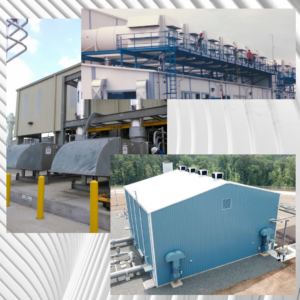Upgrades to Include in Your Industrial Ventilation System
A well-designed industrial ventilation system may require more than just supply and exhaust fans. We all know that fans are needed to make a ventilation system run. T hey are to a ventilation system what an engine is to a car. Just like choosing a new car, the goals and requirements of your ventilation system will determine what “upgrades” are needed to optimize the performance of your ventilation system. Here are some of the upgrades that may be needed to make your ventilation system run like a sports car.
hey are to a ventilation system what an engine is to a car. Just like choosing a new car, the goals and requirements of your ventilation system will determine what “upgrades” are needed to optimize the performance of your ventilation system. Here are some of the upgrades that may be needed to make your ventilation system run like a sports car.
Spot Cooling Fans
When an industrial ventilation system is supplying enough air to a building so that the inside temperature is the same as the outside temperature, adding spot cooling fans is a great way to provide additional cooling for employees, equipment and/or products. Whether you decide to use turbulence fans or HVLS style fans the key to spot cooling is determining the spread and throw, and placing them where they will provide the most benefit.
Indirect Evaporative Coolers
An indirect evaporative cooler provides the cooling power of water evaporation without the downside of adding moisture to the air or increasing your carbon footprint. When the requirement for a ventilation system is to keep the temperature inside the building below the point where employees start to loose productivity, an indirect evaporative cooling system is a great alternative to DX or chilled water air conditioning. Indirect evaporative coolers are also a great way to economically pre-cool make-up air for air conditioning systems.
Louvers
Any industrial ventilation system that utilizes gravity ventilation openings in the walls for either the supply or exhaust side will need a way to protect the openings from the weather. Louvers are one option to keep out rain. There are many blade, frame, and material options to choose from, and can be custom sized to fit your opening. The key with louvers is sizing them to allow for the appropriate air velocity through the free area. Also, do not forget to include bug and bird screens.
Dampers
While dampers are similar in appearance to louvers, they perform a different function. They can be automatically (gravity), manually, electronically, or pneumatically operated. The benefit is that they can regulate the airflow or even stop airflow in cold weather or an emergency event.
Ridge Vents
Gravity ventilation openings in roofs can be protected with ridge vents. They are a great way to let hot air out and keep rain from coming in. They come in all shapes and sizes from low profile for light industrial to large clam shaped for heavy industrial.
Dehumidifiers
When you need to remove moisture from the air in a contained industrial space, dehumidifiers are the way to go. Dehumidifiers allow you to maintain a proper relative humidity for applications that are sensitive to moisture in the air. Depending on the moisture specification, you can choose from either a refrigerant or desiccant style dehumidifier.
Silencers
Silencers are essential to maintaining worker comfort and lowering individual noise stress levels. Sometimes ventilation equipment can get extremely noisy just by the nature of the application. Silencers offer much-needed relief from this noise and in some situations, it is required by federal worker and property line noise level regulations. We have worked with every kind of silencer from steam and gas blowdown silencers to ventilation silencers to acoustical enclosures.
Air Filters
Air filters are often used in conjunction with fans. If you need ventilation but you also need to keep your factory clean, you should add air filters to your ventilation systems. We can provide anything from low grade filters to catch the big bugs to HEPA filters that will remove the dust and particles you can’t see.
Dust Collectors
Dust collectors perform a similar duty to air filters, but they are much more heavy duty. For example, if you have a cutting application that causes a lot of sawdust or metal particulates to enter the air, a dust collector picks up the contaminants through a vacuum system and then places the air back in the space or outside after the particulates are removed.
Heaters
A ventilation system should provide comfort for employees year-round. In parts of the country where it is often below freezing during the winter, a heater can take the chill out of the air and keep employees, warm and productive.
Conclusion
If you need help determining which upgrades will optimize your industrial ventilation system, Eldridge’s ventilation and noise control experts can help you make the right decision for your application.

